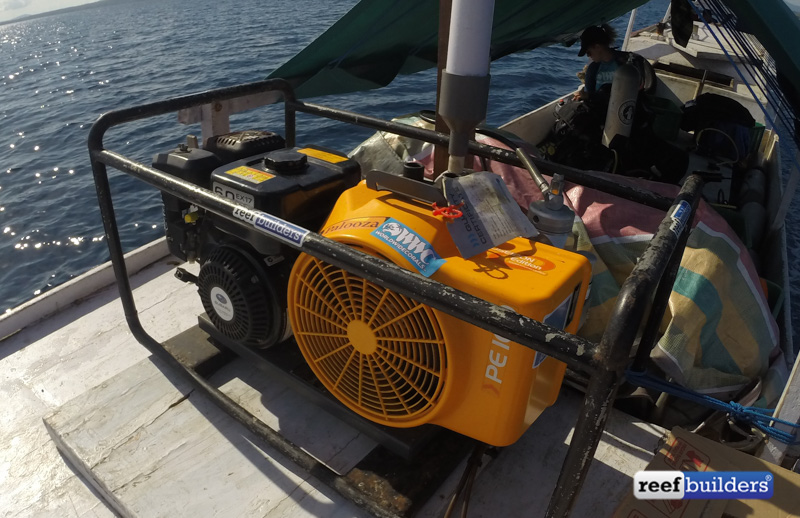We are back from an epic road trip through central Indonesia where we’ve been looking far and wide for rare fish and awesome corals. It is safe to say our journey was a success however, this really got us thinking about the heart of our expedition, our breathing/diving air compressor, and some of the unseen aspects of what it takes to collect fish and corals on remote coral reefs.
In the wild fish and corals are not always that easy to get to, yet somehow they make it from these far away places, to our LFS, and if we’re lucky right into our homes. We are able to culture some corals in shallow corals farms, where a mask and snorkel is enough to get the job done. But when you are looking for something a little more special, you’re gonna have to have a boat and you’ll need a way to stay underwater.
For this trip we brought along a Bauer Poseidon PE100 Compressor and we were able to fill our standard 18L aluminum dive tanks (one at a time) to 200bar or 3000psi of pressure in just under 20 minutes. The compressor we used runs off a four stroke Subaru petrol engine, and the PE100 model is also available with a three-phase AC motor or single-phase AC motor.
The PE100 compressor works by pulling air from the surrounding environment through a primary intake filter into the compressor’s first stage. Before reaching the scuba cylinder the air passes through three compression stages, an air purification filter, and a condensate (oil/water) separator.
The condensate separator must be drained several times during the filling process to remove the oil/water mixture and prevent it from entering the cylinder. During the breathing air compressions process, water is also removed from the gas (air), which can cause corrosion inside the cylinder or cause a scuba regulator to freeze underwater.
When using a petrol driven compressor it is especially important to have a long hose or pipe attached to the air intake filter which extends away from the petrol exhaust fumes. Failure to have your compressor set up this way can result in the toxic build up of Carbon Monoxide (an odorless gas) within the cylinder which is potentially lethal at depth.
Diving compressors fall into two general categories: those used for filling scuba diving cylinders, and those used for surface supplied (Hookah) diving. Having a portable air compressor to fill diving cylinders is a luxury which allowed us to have clean breathing air far from any commercial dive operations. Unfortunately, compressors are expensive, heavy, and can be difficult to maintain as parts and knowledgeable technicians are hard to come by at the ends of the earth.
Fisherman and coral collectors in remote coastal communities most often use a surface supplied compressor which has several hoses running straight from the compressor to the diver’s mouth. Hookah diving can be a dangerous affair, oil from the motor can leak into the hose often leaving an oily taste in the divers mouth, or worse the hard working motors can simply shut off leaving the diver with little time to swim to the surface without holding their breath, as this could result in a lung over expansion injury.

Unlike accredited SCUBA, training there are no regulations/training for remote Hookah collectors and divers often receive little training about the risks of decompression sickness or the nitrogen saturation level associated with breathing compressed air at depth. Hookah divers often stay underwater for hours past safe decompression levels and can surface from dives with numb limbs and other signs of decompression sickness.
Responsable aquarium exporters do try provide training for their staff on safe collection techniques for the health and safety of the diver as well as the wellbeing of the animals. Unfortunately this is not always possible with independents fish or coral collectors in remote locations where being on the water, fishing, diving and collecting is a way of life and a risk these fishermen take everyday.





